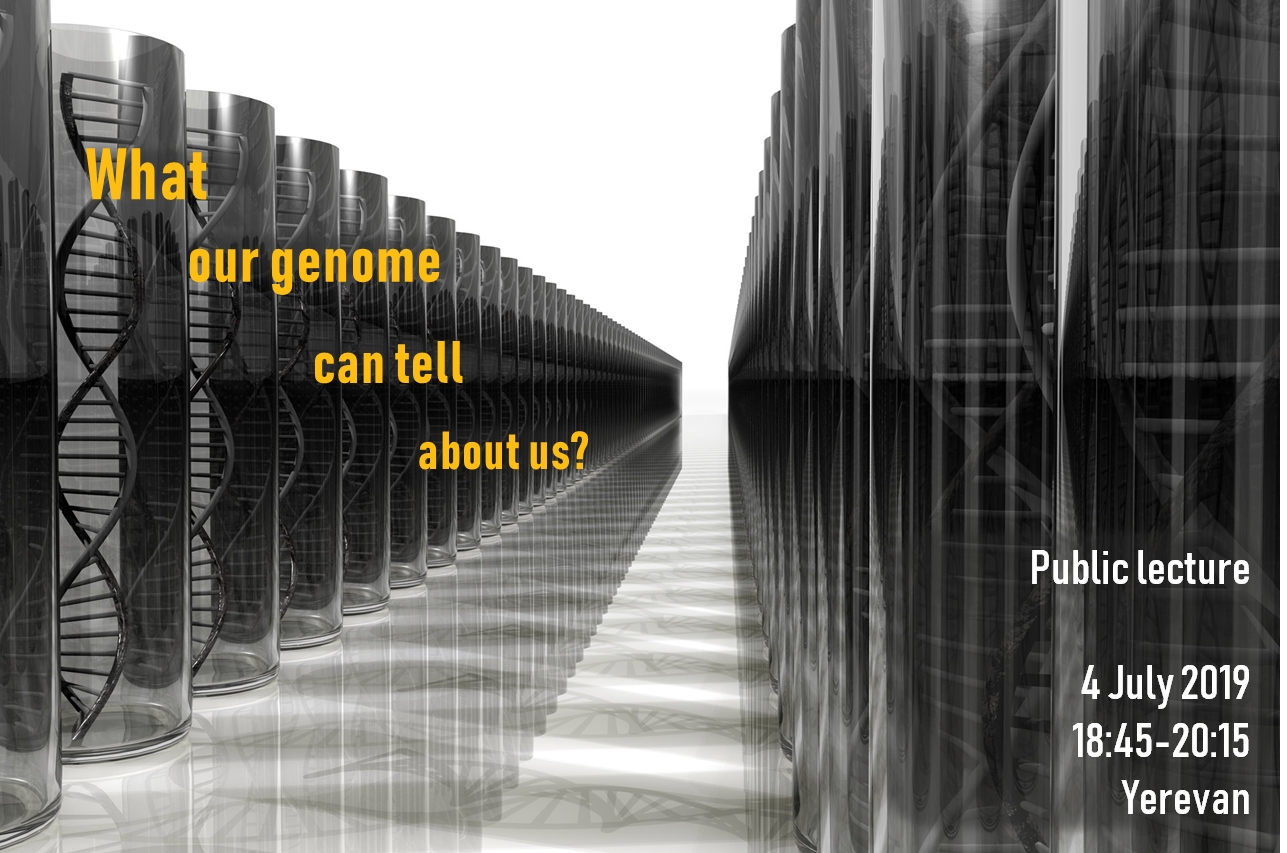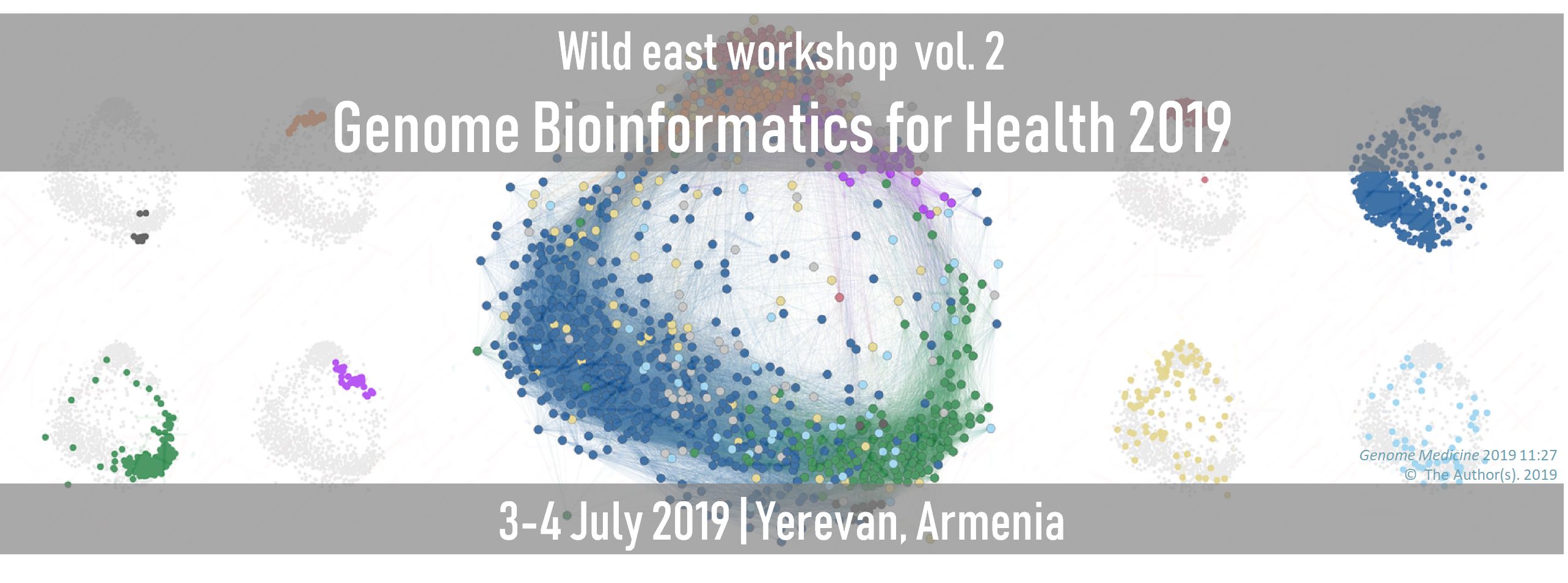Subscribe to get updates on our news and events.
What our genome can tell about us?
- What do the genes and the genome represent?
- What can they tell about us, our habits, our looks, our diseases, and our ancestry?
- How can genomics transform medicine in the 21st century?
- Why do national genome projects emerge in more and more countries?
- What are the goals of the Armenian Genome Project?
All these questions will be addressed during the public lecture by local and guest scientists that will arrive in Armenia for the “Genome Bioinformatics for Health 2019” workshop.
Genome Bioinformatics for Health 2019
The Institute of Molecular Biology (IMB) together with the Interdisciplinary Center for Bioinformatics (IZBI) at Leipzig University (Germany) and Russian-Armenian University is organizing a Bioinformatics Workshop (July 3-4, 2019).
The Workshop is aimed at students and researchers with a background in Biology, Bioinformatics, Biomedicine and/or Mathematics, Statistics, Computing.
Registration deadline – June 24, 2019
For details and to register, follow the link.
Time to learn R for bioinformatics!
The Institute of Molecular Biology (IMB) together with the Interdisciplinary Center for Bioinformatics (IZBI) at Leipzig University (Germany) is organizing courses for beginners in R and for advanced users.
Trainers
Dr. Henry Loffler-Wirth, PhD, Junior Group Leader, IZBI
Ms. Edith Willscher, PhD Student, IZBI

R for bioinformatics – a beginner’s guide (September 24 – 26, 2018)
The course objective is to introduce participants with advanced statistical and machine learning techniques and approaches used in analysis of big biological data.
Registration deadline – September 14
For details and to register, follow the course web-page: http://molbiol.sci.am/rforbio814
Scientific programming in R (September 27 – 28, 2018)
The course objective is to introduce participants with advanced statistical and machine learning techniques and approaches used in analysis of big biological data.
Registration deadline – September 14
For details and to register, follow the course web-page: http://molbiol.sci.am/rproginr814
We welcome Maria and Siras to join our staff!
After several months of working with us as volunteers, Maria Nikoghosyan and Siras Hakobyan have joined our staff.
Maria is a last year student at the faculty of Bioinformatics, Bioengineering and Molecular Biology at the Russian-Armenian University, doing her thesis in our group. She studies pathogenomic characteristics of the Armenian population .
Siras is a last year Master’s student in Bioinformatics at Yerevan State University, performing his thesis in our group. He analyzes the effects of genetic variations on pathway signal flow perturbations in cancers.

The BIG Journal Club session #17
There are physical barriers on the way of replication and transcription machinery to unwind the DNA double helix and perform synthesis of DNA or RNA molecules. Topoisomerases are the mechanisms that transiently resolve physical strains and make these lively processes possible. During the upcoming Journal Club Anna will speak about the physical barriers for replication and transcription and the mechanisms of action of different topoisomerases.
Speaker: Anna Hakobyan
Location: Arrive at the Institute of Molecular Biology, get on the 3rd Floor, turn left from the elevator, find our sign on one of the doors, enter 🙂
Date: 08 Feb 2018, Thursday
Time: 18:30
Contact: +37494 601703 (Lilit)
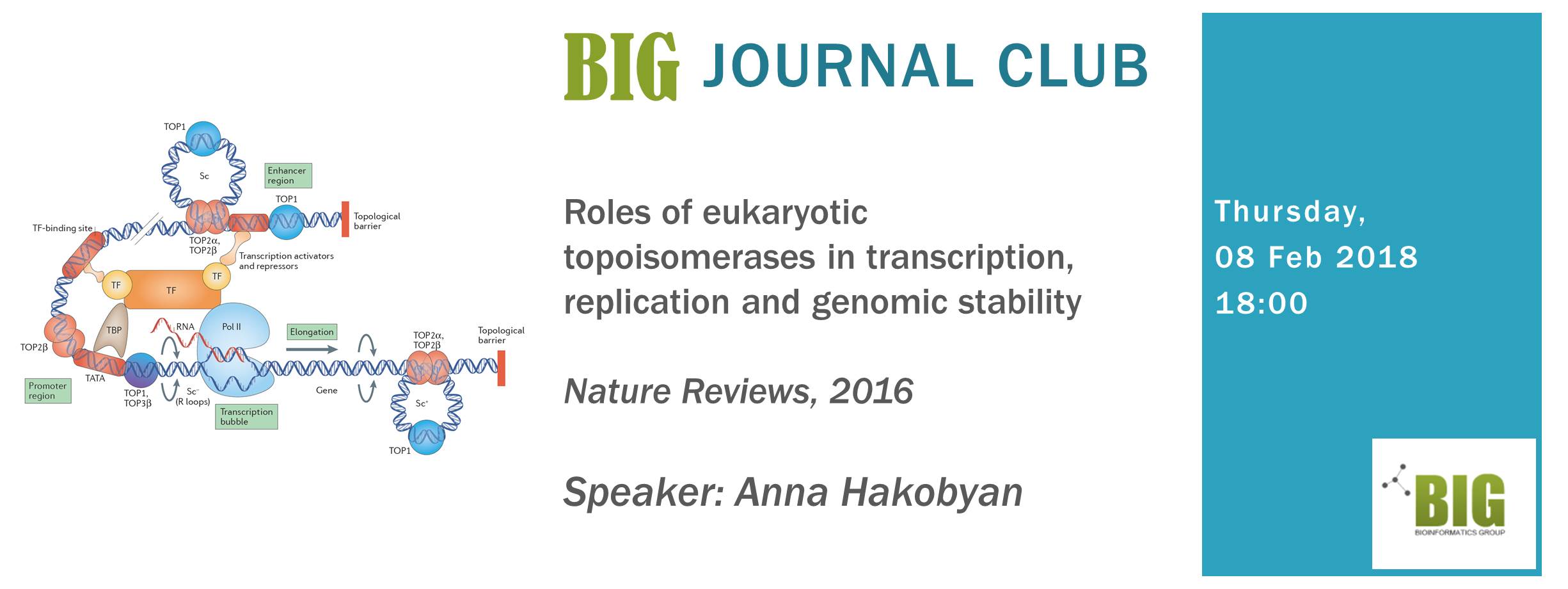
Bioinformatics and Functional Genomics: course resumed for 2018
We are happy to re-start our course series EdX course: Case studies in Functional Genomics.
The course is public and is designed for researchers and students having interest in the field. Basic background in molecular biology and programming is desired, but can also be bridged by reading.
This time the courses will be held at the Innovative Solutions and Technologies Center (ISTC). We are already discussing RNA sequencing. For further topics refer to the course webpage.
Preliminary schedule is each Thursday, at 18:30-20:00, starting January 18, 2018. For more information, please visit the course link.
Call for applications for CompBioMed research visit program (closed)
The Institute of Molecular Biology, as an associate partner of CompBioMed is joining the call by Pan-European Research Infrastructure on High Performance Computing (HPC-Europa3) to fund research visits within CompBioMed.
The HPC-Europa3 project aims at maintaining the persistency of high-quality service to transnational access to the most advance HPC infrastructures available in Europe for European research. The project is based on a program of visits, in the form of traditional transnational access, with researchers visiting HPC centres and/or scientific hosts, such as UCL, who mentor them scientifically and technically. For details on the program aims and guidelines, please visit http://www.hpc-europa.eu/node/22.
Based on this, we are announcing a call for applications to bioinformatics researchers and students based in Armenia. The interested candidates are asked to send a one page abstract of a proposed project, and their CV to big@mb.sci.am before December 9, 14:00. Selected applications will be recommended by us to CompBioMed and will further be processed to the 3rd call of HPC-Europa3.
We are starting a course: Bioinformatics and Functional Genomics
We are happy to resume our educational activities. We are planning to start a hybrid course consisting of intro to Next Generation Sequencing technologies and continuing with the EdX course: Case studies in Functional Genomics
The course is public and is designed for researchers and students having interest in the field. Basic background in molecular biology and programming is desired, but can also be bridged by reading.
The course will be held each Thursday, at 17:30-19:30, starting October 26, 2017. For more information, please visit the course link.
We are now at Science Exchange!
We are happy to announce that we have registered at Science Exchange as a service provider for Bioinformatics data analyses and customized software development. Our team provides data analysis and software development services in a wide variety of fields, including:
- NGS data analysis
- Differential gene expression profiling
- Pathway analysis
- Computational analysis of telomeres from NGS data
- Customized software development in Java, R, bash
- Consulting services
For more, visit our Science Exchange storefront.
News: Our first PhD defense!
We are happy to tell that our group’s first PhD product has been released!
The thesis, entitled “Telomere analysis based on high-throughput multi-omics data” by Lilit Nersisyan, supervised by Arsen Arakelyan, was defended in the University of Leipzig on September 1st, 2017. We’d like to thank Hans Binder (IZBI, Uni Leipzig) for his enormous support both in scientific and organizational aspects.
The study was aimed at development and applications of algorithms for analysis of Next Generation Sequencing data to study the biology of telomeres. Our programs for telomere length calculation from DNA sequencing data (Computel) and for analysis of telomere maintenance mechanisms from RNA sequencing datasets have the promise to foster telomere biology research by bringing it to high-throughput systems-biology scale.
Links to the thesis and already published papers:
- Thesis: “Telomere analysis based on high-throughput multi-omics data” PDF
- Nersisyan L. Integration of Telomere Length Dynamics into Systems Biology Framework: A Review. Gene Regul Syst Bio. 2016, 10:35-42. PubMed Full text
- Hakobyan A, Nersisyan L, Arakelyan A. Quantitative trait association study for mean telomere length in the South Asian Genomes. Bioinformatics 2016, 32(11):1697-700. PubMed Full text
- Nersisyan L, Arakelyan A. Computel: computation of mean telomere length from whole-genome next-generation sequencing data. PLoS One 2015, 10(4):e0125201. PubMed Full text
- Nersisyan L, Johnson G, Riel-Mehan M et al. PSFC: a Pathway Signal Flow Calculator App for Cytoscape [version 1; referees: 1 approved] F1000Research 2015, 4:480. PubMed Full text
The BIG Journal Club session #15
It is common to perform gene expression experiments on mice or other model organisms and extrapolate the findings onto humans. How valid is such an extrapolation? We know that gene expression is a dynamic variable that varies not only between different species, but also between tissues and organs in the same individual. It is thus important to distinguish the variations in gene expression across tissues and between species, to reveal the commonalities that reflect evolutionary conservation, and differences that reflect organ’s response to the environment.
Analysis of patterns of gene expression across tissues has been the topic of Ani’s recent capstone with which she graduated from AUA CIS master’s program. On Thursday, we’ll see how this work differs from her diploma work.
Presenter: Ani Sakhlyan
Location: Arrive at the Institute of Molecular Biology, get on the 3rd Floor, turn left from the elevator, find our sign on one of the doors, enter 🙂
Date: 25 May 2017, Thursday (! note the weekday change)
Time: 18:00
Contact: +37494 601703
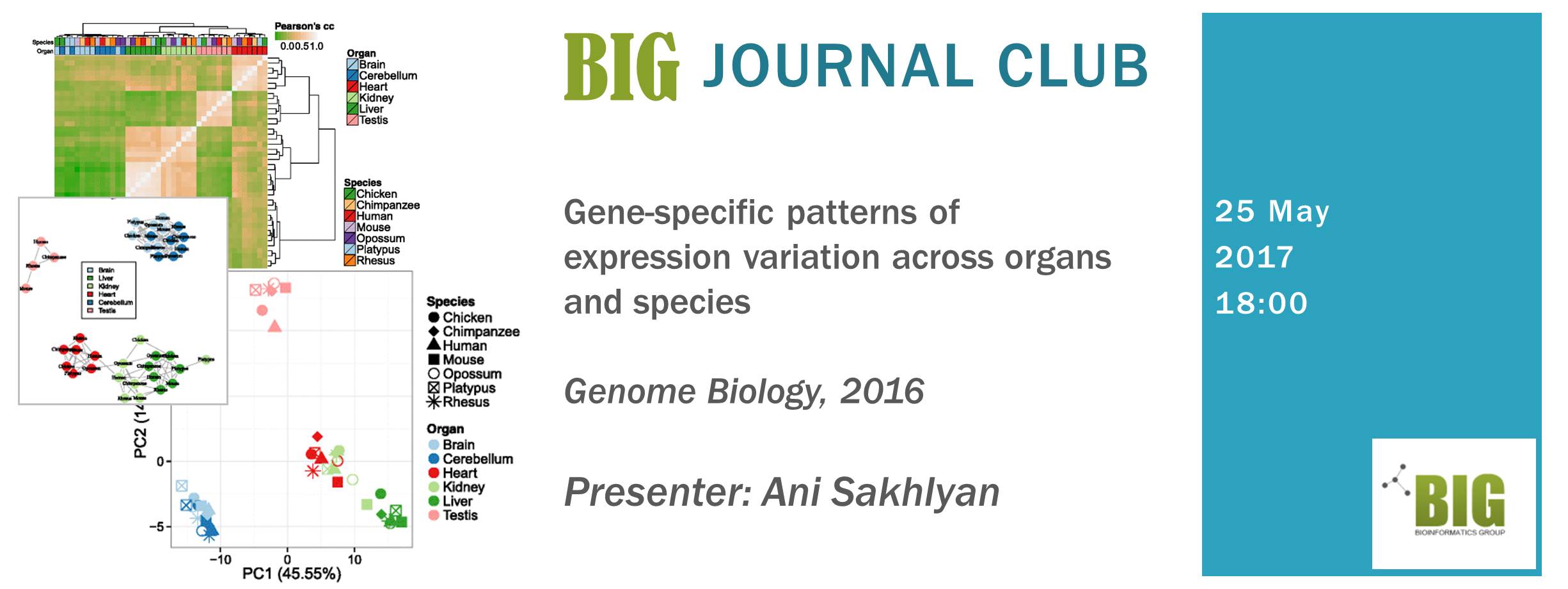
The BIG Journal Club session #14
A probably inaccurate estimate of the number of various proteins in a cell is on a scale of 10 000 (20-100). There is an astronomic number of possible interactions between them, however, it is reasonable to believe that the number of actually realized interactions will be less than “astronomical”. Even so, the number of interactions available in the literature is far less than the expected actual number. There are many interaction databases that store such information, which are sometimes inaccurate or incomplete.
The study Ani will talk about on Thursday has had a rather ambitious aim of curating a high-quality human interactome map by literature search and experimental procedures. This study has been conducted in Dana-Farber Cancer Institute, where Ani hopes to do an internship this summer 🙂
Presenter: Ani Khachatryan
Location: Arrive at the Institute of Molecular Biology, get on the 3rd Floor, turn left from the elevator, find our sign on one of the doors, enter 🙂
Date: 18 May 2017, Thursday (! note the weekday change)
Time: 18:00
Contact: +37494 601703
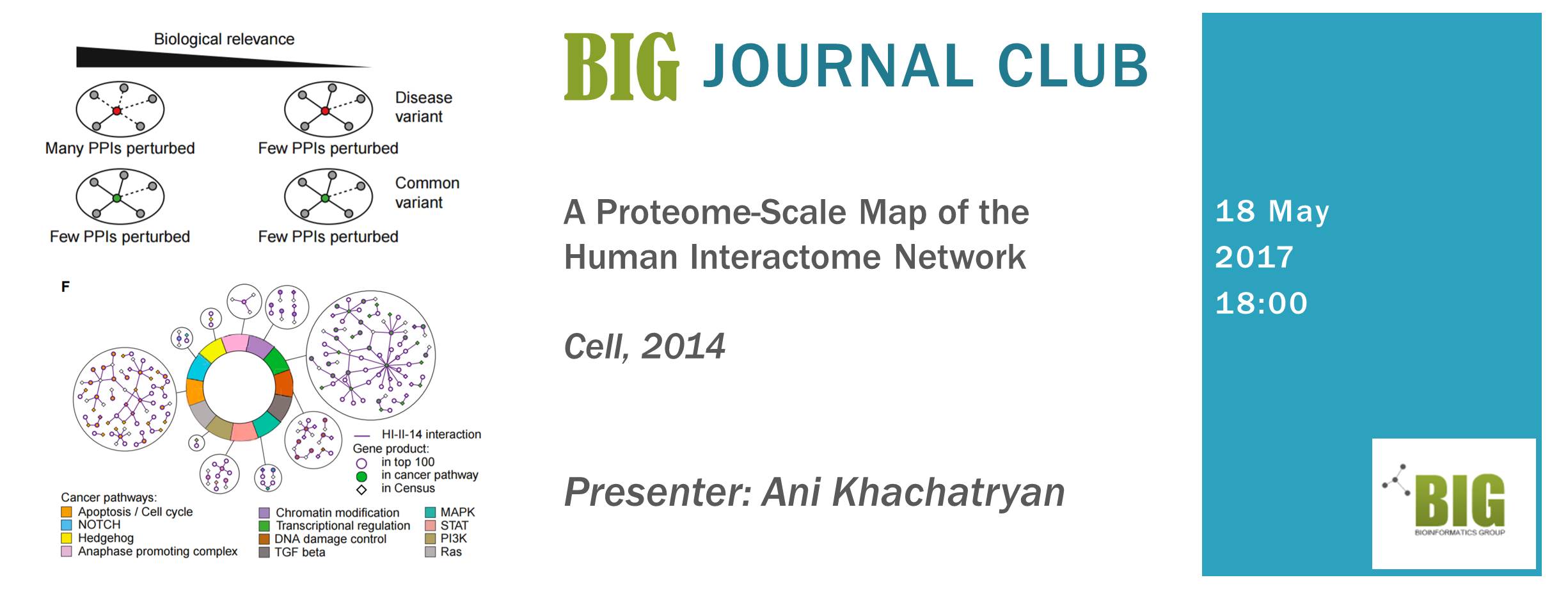
The BIG Journal Club session #13
Our genes shape what we can be. The epigenetic states of our genes then shape the current morphology and behavior of differentiated cells. Epigenetics, thus, shapes what we are right now. Is there a way for our cells to remember what we have been before? How do our cells react to the environment? Do the stimuli from the environment cause temporary reactions, or is there a cellular memory associated with those exposures?
During our meeting, we will discuss a paper about latent enhancers: regulators of gene activity and cell state that get activated upon receiving certain signals. They are also the keepers of cellular memory that remember if they have been activated before or not.
Presenter: Maria Nikoghosyan
Location: Arrive at the Institute of Molecular Biology, get on the 3rd Floor, turn left from the elevator, find our sign on one of the doors, enter 🙂
Date: 11 May 2017, Thursday (! note the weekday change)
Time: 18:00
Contact: +37494 601703

The BIG Journal Club session #12
Technologies move fast. And our perception is that algorithmic support to the data generated by high-throughput sequencing platforms is lagging. It’s possible to obtain information from multiple levels of cell state: the genome, transcriptome and epigenome. The main algorithmic challenge to handle these data is integration of the multi-level information into a sysems biology framework.
In the next meeting we will discuss a paper that has suggested an approach to handle multi-omics data integratively and with the use of signaling networks.
Presenter: Siras Hakobyan
Location: Arrive at the Institute of Molecular Biology, get on the 3rd Floor, turn left from the elevator, find our sign on one of the doors, enter 🙂
Date: 04 May 2017, Thurday (! note the weekday change)
Time: 18:00
Contact: +37494 601703

The BIG Journal Club session #11
A cure to blindness, Parkinson’s diseases, diabetes and osteoporosis? Having organ transplants grown from the patient’s own cells? Killing less animals in the lab, while having better experimental models for diseases and their treatment? The answer to these questions is tricky to pronounce, but everyone will learn to sooner or later: induced pluripotent stem cells, or iPSCs. Their discovery has led to happy and sad moments in history: from Nobel Prize to a suicide, from hope of curing a series of incurable diseases – to tragic “stem cell therapies” performed in clinics.
Even though the word pluripotent means able to differentiate into any type of cells, their differentiation potential is, in fact, limited: you never know what type of a cell you’ll get, until you observe it differentiating. And this is where bioinformatics may be of help: can we guess the type of iPSCs? What approaches do scientists use for this? On Tuesday we’ll discuss if we have anything to do in this intriguing field.
Presenter: Lilit Nersisyan
Location: Arrive at the Institute of Molecular Biology, get on the 3rd Floor, turn left from the elevator, find our sign on one of the doors, enter 🙂
Date: 25 April 2017, Tuesday
Time: 18:00
Contact: +37494 601703

The BIG Journal Club session #10
Anna will tell about a study inspired by the ovarian cancer of its author. She not only published a fine paper, but used the study results to choose an unconventional chemotherapy regimen for herself, as gene expression of her tumor suggested a successful immune activation. The chemotherapy was a great choice either due to molecular factors, or a strong placebo effect. Nonetheless, she’s alive and happy.
Now that we’ve got the emotional part set up, the event will be mostly dedicated to the CorEx algorithm used in the study, which was developed by Greg Ver Steeg and Aram Galstyan.
Presenter: Anna Hakobyan
Location: Arrive at the Institute of Molecular Biology, get on the 3rd Floor, turn left from the elevator, find our sign on one of the doors, enter 🙂
Date: 18 April 2017, Tuesday
Time: 18:00
Contact: +37494 601703
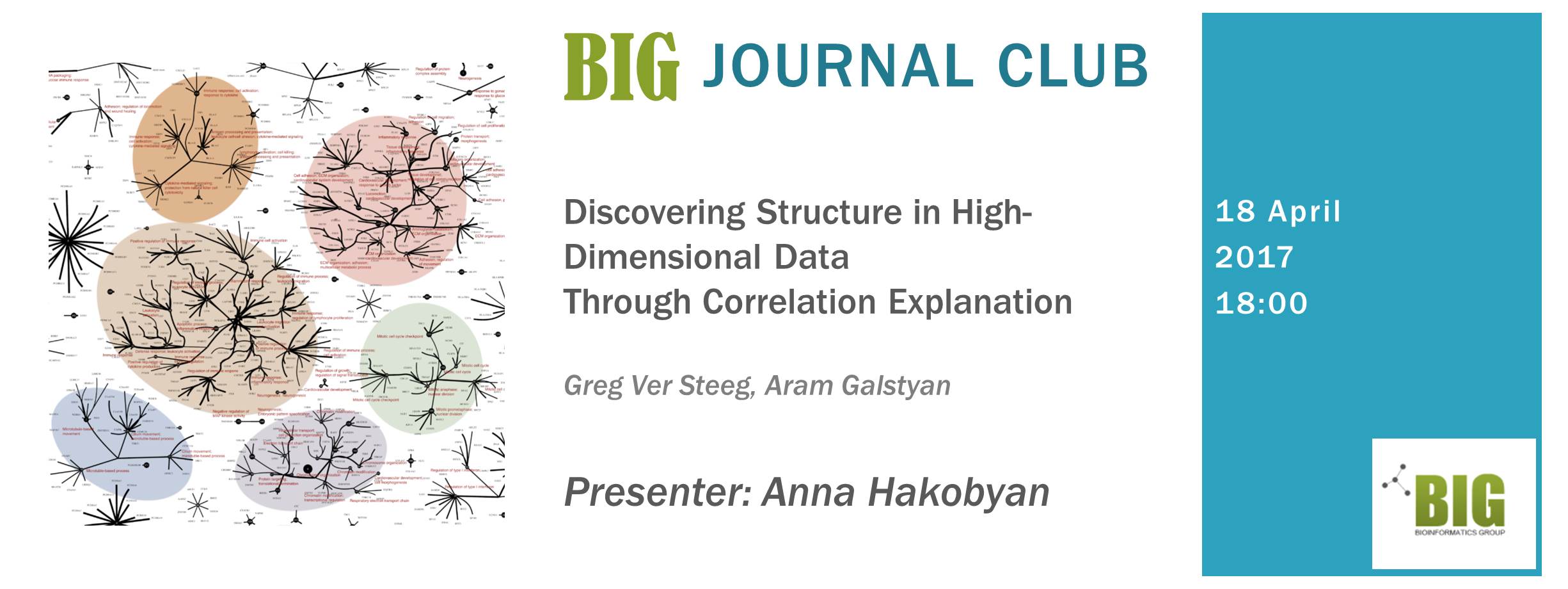
The BIG Journal Club session #8 – Resumed
The 8th Journal Club session will be coming this Tuesday 🙂
Ever wonder why despite the “fantastic” progress in biology, we don’t get new treatments with similar “fantastic” efficiency? Well it takes quite long until a genius idea converts into a newly synthesized drug; and it takes even longer (actually, much, much longer) until that drug reaches the market. What if we take existing drugs that have already passed the painful path of “approvals” and use them for treating other diseases, in other words – repurpose them? That would be awesome! The challenge is – how do you find repurposable drugs and their target diseases?
On Tuesday, Arsen will tell us about computational methods for finding cheap treatments to existing diseases.
Presenter: Arsen Arakelyan
Location: Arrive at the Institute of Molecular Biology, get on the 3rd Floor, turn left from the elevator, find our sign on one of the doors, enter 🙂
Date: 11 April 2017, Tuesday
Time: 18:00
Contact: +37494 601703
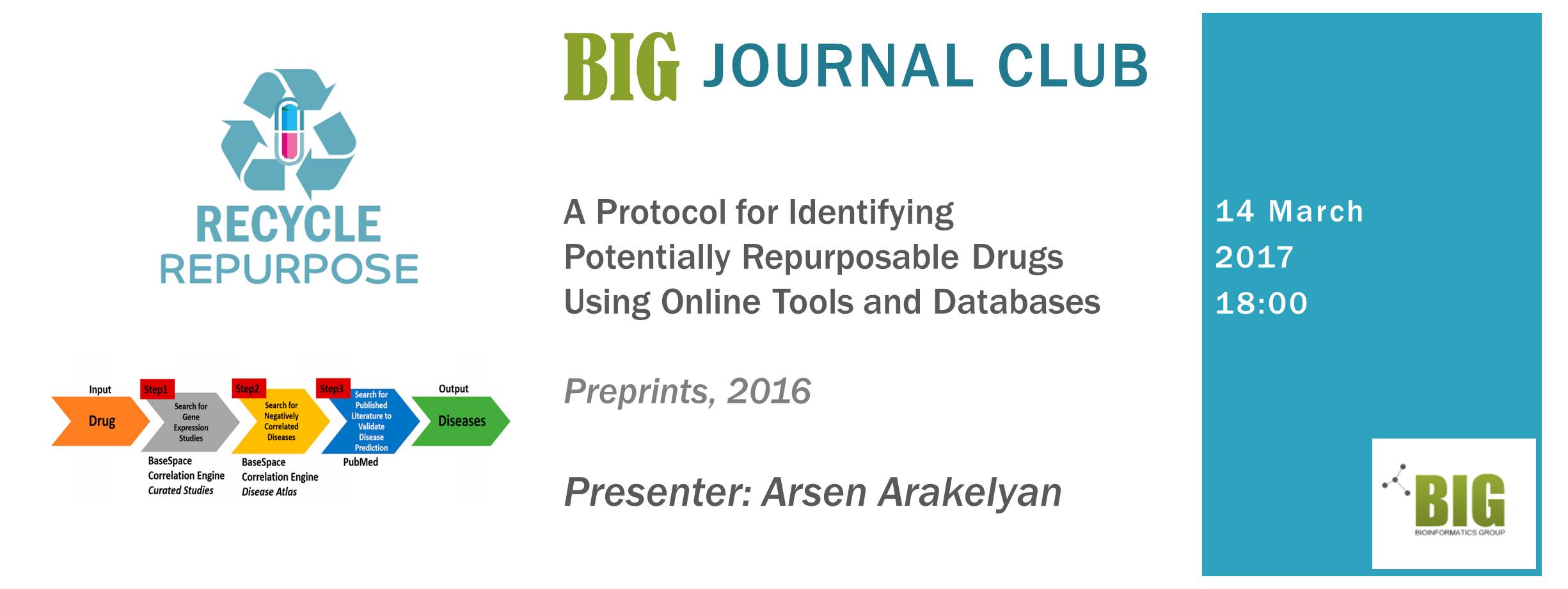
The BIG Journal Club session #9
Why do most healthy cells divide only a limited number of times, while cancer cells divide infinitely? Many think that one of the necessary factors is the ability of cancer cells to elongate the ends of their chromosomes – the telomeres. Is it possible to target telomere elongation mechanisms in anti-cancer therapies? Would such therapies stop cancer cells from dividing? This will be discussed during our next meeting. We will also present the computational approach that we have developed in our group to predict the ability of cancer cells to elongate their telomeres.
Presenter: Lilit Nersisyan
Location: Arrive at the Institute of Molecular Biology, get on the 3rd Floor, turn left from the elevator, find our sign on one of the doors, enter 🙂
Date: 04 April 2017, Tuesday
Time: 18:00
Contact: +37494 601703
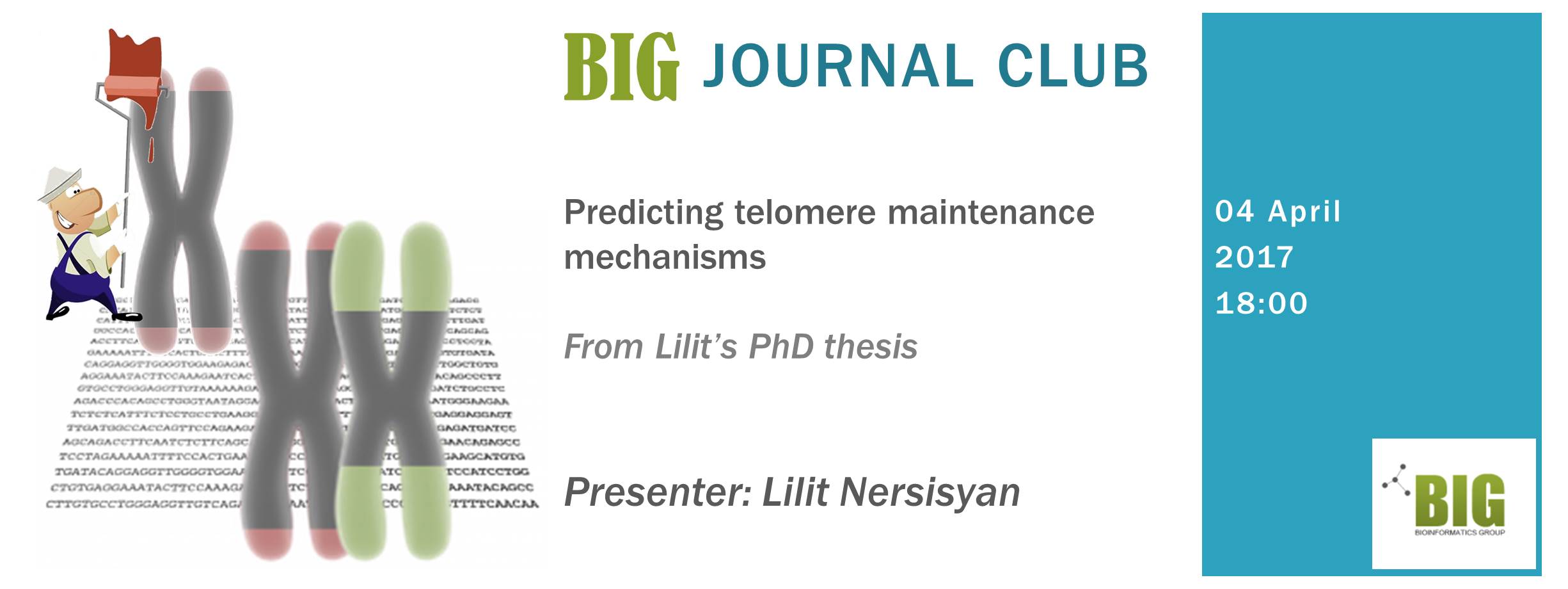
The BIG Journal Club session #8
Ever wonder why despite the “fantastic” progress in biology, we don’t get new treatments with similar “fantastic” efficiency? Well it takes quite long until a genius idea converts into a newly synthesized drug; and it takes even longer (actually, much, much longer) until that drug reaches the market. What if we take existing drugs that have already passed the painful path of “approvals” and use them for treating other diseases, in other words – repurpose them? That would be awesome! The challenge is – how do you find repurposable drugs and their target diseases?
On Tuesday, Arsen will tell us about computational methods for finding cheap treatments to existing diseases.
Presenter: Arsen Arakelyan
Location: Arrive at the Institute of Molecular Biology, get on the 3rd Floor, turn left from the elevator, find our sign on one of the doors, enter 🙂
Date: 14 March 2017, Tuesday
Time: 18:00
Contact: +37494 601703

The BIG Journal Club session #7
Do you know how sequencing is performed? DNA from many cells is mixed and amplified to rich a signal intense enough to be captured by machines. And suddenly we are talking about single cell sequencing! Is it possible to get a valid signal from an amount of DNA as low as that contained within a single cell? Ashkhen will try to convince us that this “burning” topic of the last years is not a trick, but a serious business 🙂
Presenter: Ashkhen Mkhitaryan (Instigate Design)
Location: Arrive at the Institute of Molecular Biology, get on the 3rd Floor, turn left from the elevator, find our sign on one of the doors, enter 🙂
Date: 07 March 2017, Tuesday
Time: 18:00
Contact: +37494 601703
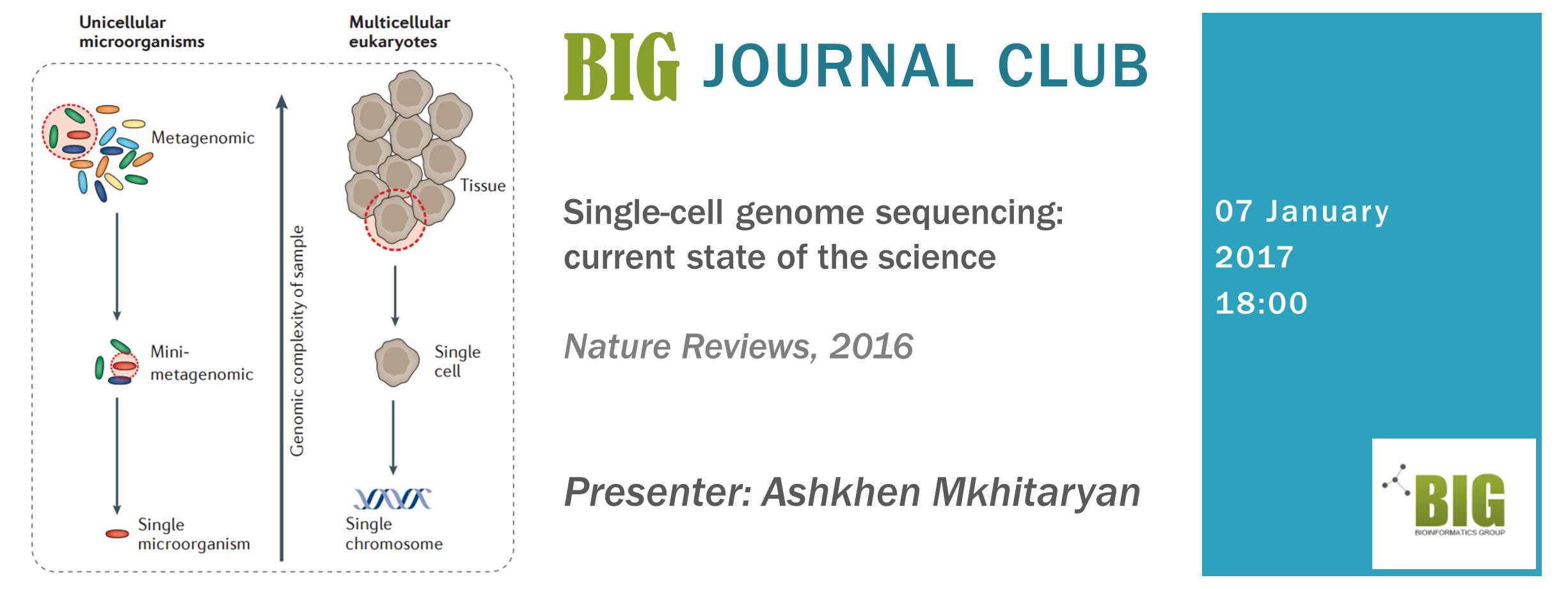
The BIG Journal Club session #6
Anna will talk about her favorite topic: RNAs. This time: circular RNAs! Yet another regulatory level of which we haven’t heard a lot, but which is trending now in the world of functional genomics.
Presenter: Anna Hakobyan
Location: Arrive at the Institute of Molecular Biology, get on the 3rd Floor, turn left from the elevator, find our sign on one of the doors, enter 🙂
Date: 28 February 2017, Tuesday
Time: 18:00
Contact: +37494 601703
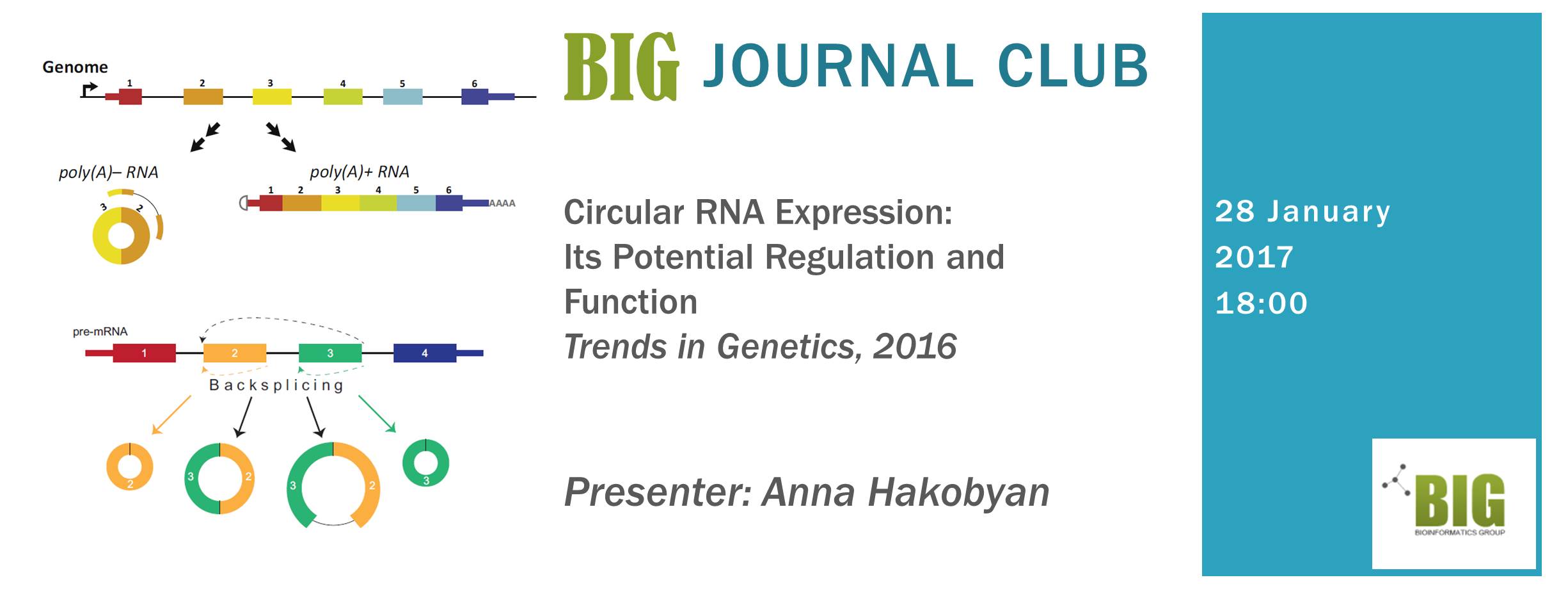
The BIG Journal Club session #5
BIGeeks are presenting: celebrite the Valentine’s day with us!
Anna will talk about Singular value decomposition, principal component analysis and other romantic and cheesy stuff! Candle lights will be provided ^_^
Presenter: Anna Hakobyan
Location: Arrive at the Institute of Molecular Biology, get on the 3rd Floor, turn left from the elevator, find our sign on one of the doors, enter 🙂
Date: 14 February 2017, Tuesday
Time: 18:00
Contact: +37494 601703
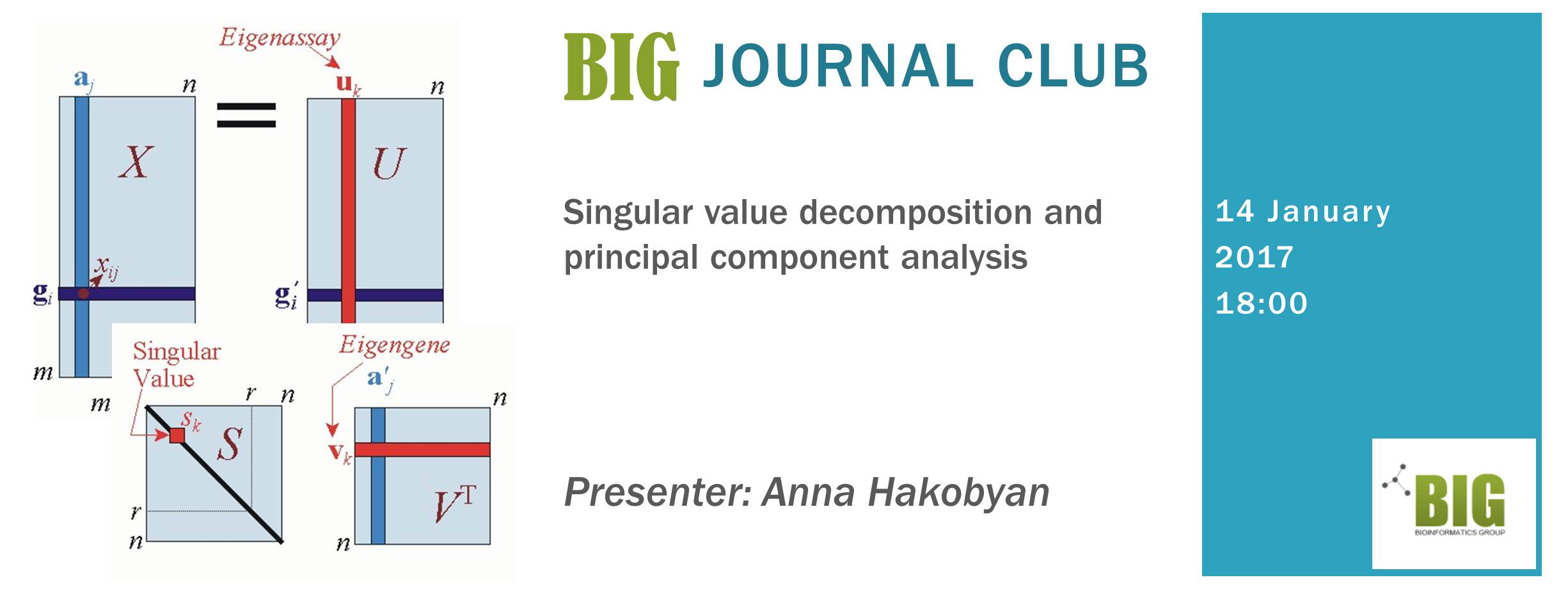
The BIG Journal Club session #4
Biology is complex: several layers of regulatory interactions exist in each cell that altogether shape who you are right now. And once you think that after twenty years of studying all the existing regulatory layers you may finally be called a scientist, there comes this paper destroying all your previous ambitions. This paper will describe the extra layer of regulation you probably haven’t thought about before: the tRNA level.
Meet us on Tuesday and share the excitement, pain, happiness, whatever 🙂
. Open Biology, 2016. Full text
Presenter: Maria Nikoghosyan
Location: Arrive at the Institute of Molecular Biology, get on the 3rd Floor, turn left from the elevator, find our sign on one of the doors, enter 🙂
Date: 07 February 2017, Tuesday
Time: 18:00
Contact: +37494 601703
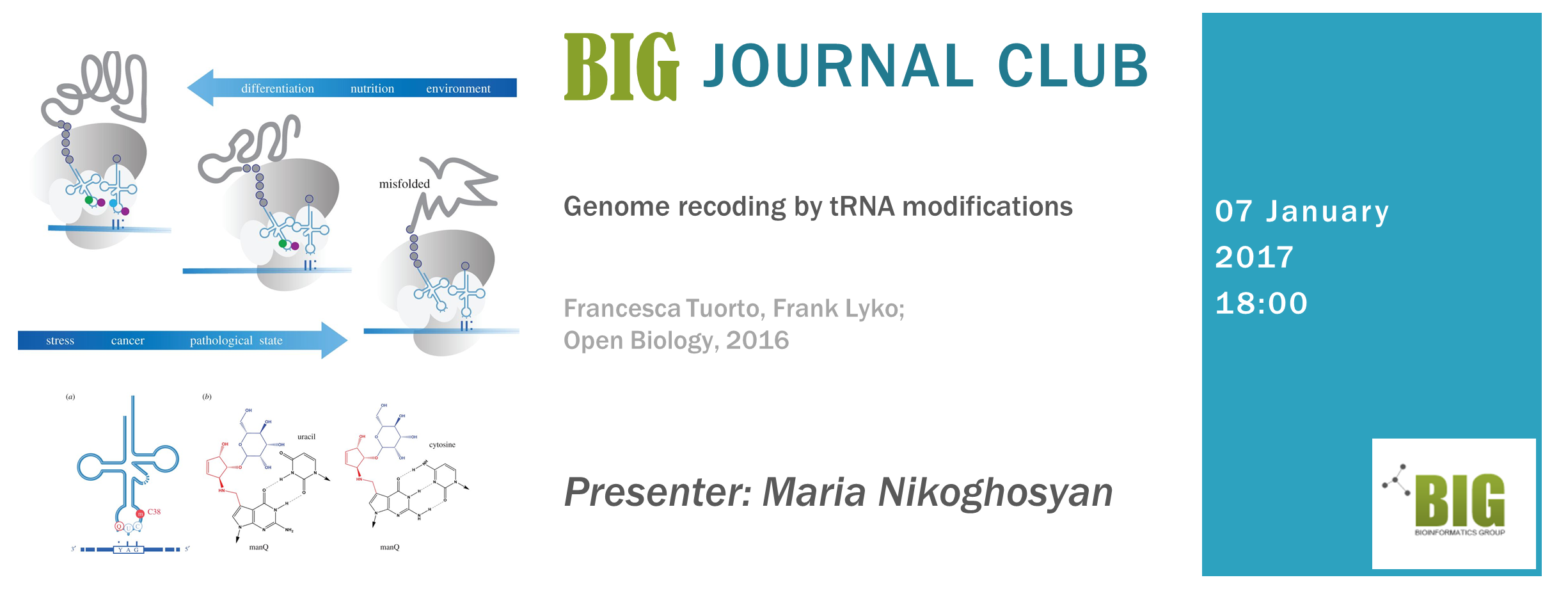
The BIG Journal Club session #3
Biologocial pathways have long been there. And scientists (including us :)) have long thought about proper analysis of signal propagation through the pathways. However, no consensus is there yet, and this topic is still open for brainstorming.
On Tuesday, we will discuss the following paper that discusses one way of analyzing signal propagation through pathways:
. arXiv 2006163, 1-17. Full text
Presenter: Arsen Arakelyan
Location: Arrive at the Institute of Molecular Biology, get on the 3rd Floor, turn left from the elevator, find our sign on one of the doors, enter 🙂
Date: 31 January 2017, Tuesday
Time: 18:00
Contact: +37494 601703
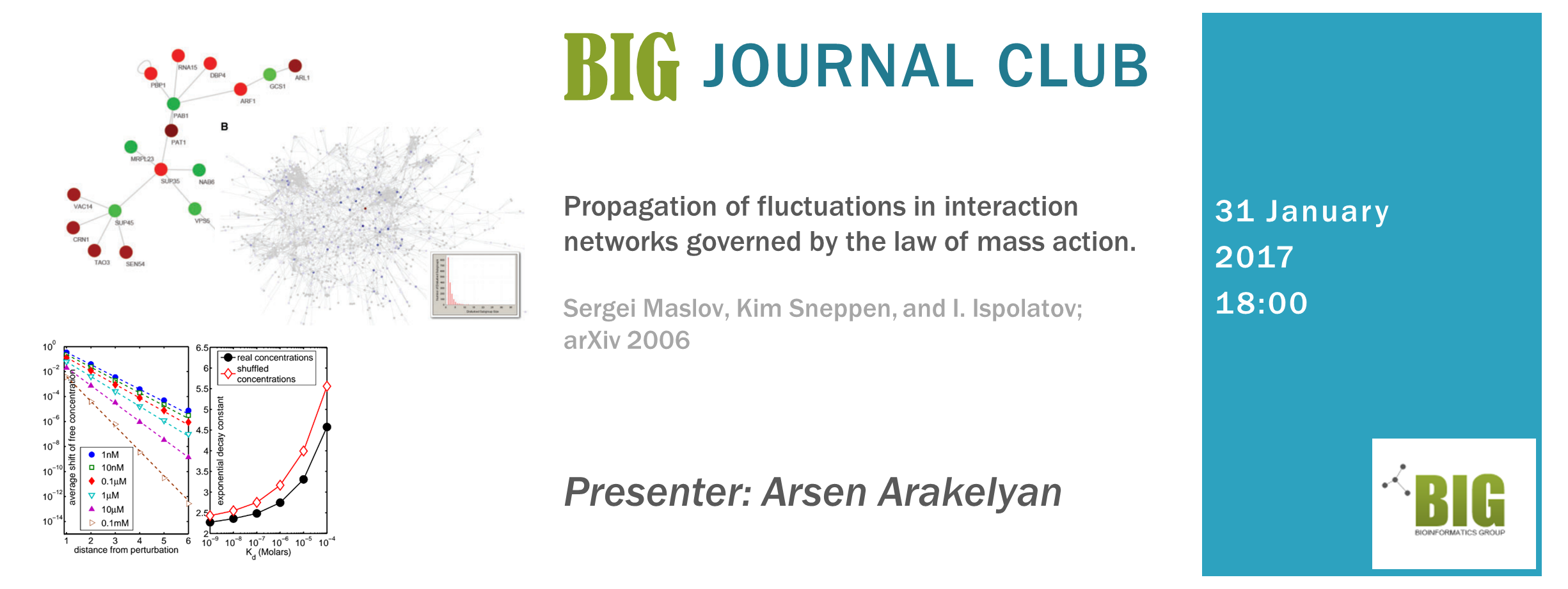
The BIG Journal Club session #2
We will discuss the following paper:
. Cell 163, 1-17. PubMed Full text
Presenter: Lilit Nersisyan
Location: Find us at the Institute of Molecular Biology, get on the 3rd Floor, turn left from the elevator, find our sign on one of the doors, enter 🙂
Date: 24 January 2017, Tuesday
Time: 18:00
Contact: +37494 601703
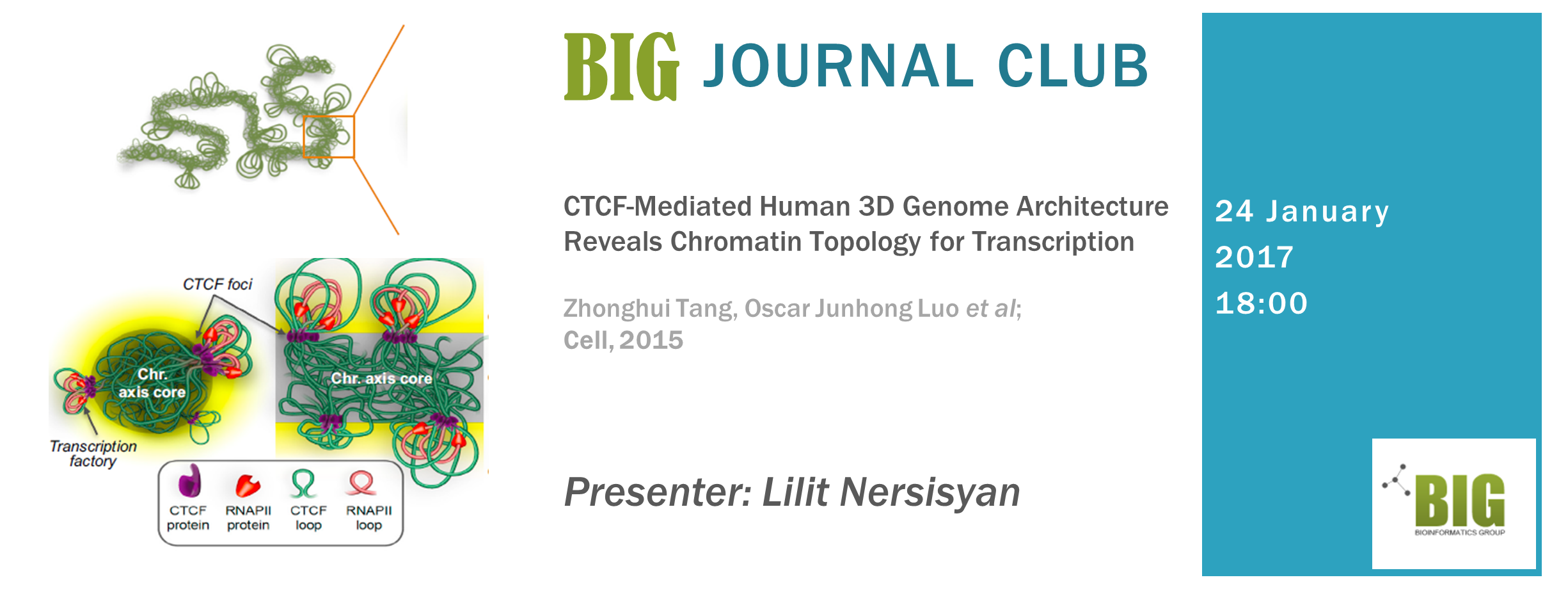
The BIG Journal Club session #1
We will discuss the following paper:
& Alternative splicing and evolution: diversification, exon definition and function. Nature Reviews Genetics 11, 345–355. PubMed PDF
Presenter: Anna Hakobyan
Location: Find us at the Institute of Molecular Biology, get on the 3rd Floor, turn left from the elevator, find our sign on one of the doors, enter 🙂
Date: 17 January 2017, Tuesday
Time: 18:00

The BIG Journal Club
We are starting our weekly Journal Club!
We decided to make the journal club sessions public, so that anyone interested in hard-core scientific discussions is welcome to attend.

